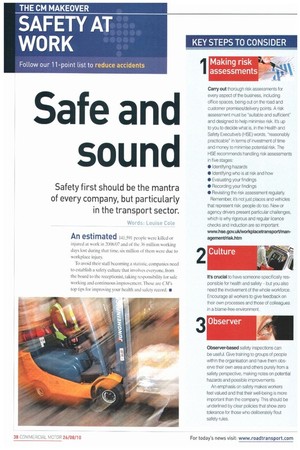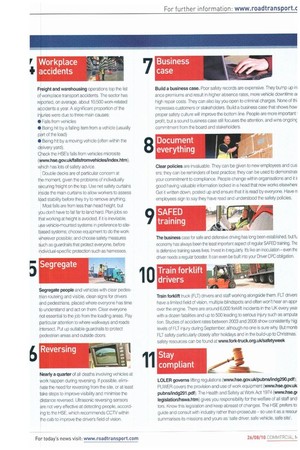Safe and sound
Page 38

Page 39

If you've noticed an error in this article please click here to report it so we can fix it.
Safety first should be the mantra of every company, but particularly in the transport sector.
Words: Louise Lute
An estimated 141,591 people were killed or injured at work in 2006/07 and of the 36 million working days lost during that time, six million of them were due to workplace injury.
To avoid their staff becoming a statistic. companies need to establish a safety culture that involves everyone, from the board to the receptionist, taking responsibility for safe working and continuous improvement. These are CM's top tips for improving your health and safety record. •
KEY STEPS TO CONSIDER
Making risk assessments
Carry out thorough risk assessments for every aspect of the business, including office spaces, being out on the road and customer premises/delivery points. A risk assessment must be "suitable and sufficient" and designed to help minimise risk. It's up to you to decide what is, in the Health and Safety Executive's (HSE) words, "reasonably practicable" in terms of investment of time and money to minimise potential risk. The HSE recommends handling risk assessments in five stages: • Identifying hazards • Identifying who is at risk and how • Evaluating your findings • Recording your findings • Revisiting the risk assessment regularly. Remember, ifs not just places and vehicles that represent risk: people do too. New or agency drivers present particular challenges, wh+ch is why rigorous and regular licence checks and induction are so important. www.hse.gov.ukiworkplacetransport/management/risk.htm
2
It's crucial lo have someone specifically responsible for health and safety -but you also need the involvement of the whole workforce. Encourage all workers to give feedback on their own processes and those of colleagues in a blame-free environment.
Observer
Observer-based safety inspections can be useful. Give training to groups of people within the organisation and have them observe their own area and others purely from a safety perspective, making notes on potential hazards and possible improvements.
An emphasis on safety makes workers feel valued and that their well-being is more important than the company. This should be underlined by clear policies that show zero tolerance for those who deliberately flout safety rules. Freight and warehousing operations top the list ol workplace transport accidents. The sector has reported, on average, about 10,500 work-related accidents a year. A significant proportion of the injuries were due to three main causes: • Falls from vehicles
II Being hit by a falling item from a vehicle (usually part of the load)
• Being hit by a moving vehicle (often within the delivery yard).
Check the HSF's falls from vehicles microsite 1:www.hse.gov.uk/fallsfromvehicles/index.htm:1 which has lots of safely advice.
Double decks are of particular concern at the moment, given the problems of individually securing freight on the top. Use net safety curtains inside the main curtains to allow workers to assess load stability before they try to remove anything.
Most falls are from less than head height. but you don't have to fall far to land hard. Ptan lobs so that working at height is avoided, tf it is inevitable. use vehicle-mounted systems in preference to sitebased systems; choose equipment to do the work Wnerever possible; and choose safety measures such as guardrails that protect everyone, before individual-specific protection such as harnesses.
Segregate people and vehicles with clear pedestrian routeing and visible, clean signs for drivers and pedestrians, placed where everyone has time to understand and act on them. Clear everyone not essential to the job from the loading areas. Pay particular attention to where walkways and roads intersect. Put up suitable guardrails to protect pedestrian areas and outside doors.
Nearly a quarter of all deaths involving vehicles at work happen during reversing. If possible, eliminate the need for reversing from the site, or at least take steps to improve visibility and minimise the distance reversed. Ultrasonic reversing sensors are not very effective at detecting people, according to the HSE. which recommends CCTV within the cab to improve the driver's field of vision_
Business case
Build a business case. Poor safety records are expensive. They bump up in ance premiums and result in higher absence rates, more vehicle downtime ai high repair costs. They can also lay you open to criminal charges. None of thi impresses customers or stakeholders. Build a business case that shows how proper safety culture will improve the bottom line. People are more important profit, but a sound business case still focuses the attention, and wins ongoinc commitment from the board and stakeholders.
8
Clear policies are invaluable. They can be given to new employees and cus ers; they can be reminders of best practice; they can be used to demonstrat your commitment to compliance. People change within organisations and it i: good having valuable information locked in a head that now works elsewherE Get it written down. posted up and ensure that it is read by everyone. Have n employees sign to say they have read and understood the safety policies.
9
The business case for safe and defensive driving has long been established, but economy has always been the least important aspect of regular SAFED training. The is defensive training saves lives. Invest in it regularly. It's like an inoculation even the driver needs a regular booster. It can even be built into your Dover CPC obligation.
10
Train forklift truck (FLT) drivers and staff working alongside them. FLT drivers have a limited field of vision, multiple blindspots and often won't hear an appr over the engine. There are around 6,000 forklift incidents in the UK every year with a dozen fatalities and up to 500 leading to serious injury such as amputa tion. Studies of accident rates between 2003 and 2008 show consistently hig levels of FLT injury during September. although no one is sure why. But monit FLT safety particularly closely after holidays and in the build-up to Christmas. safety resources can be found at www.fork-truck.org.uk/safetyweek 11 Stay
LOLER governs lifting regulations (www.hse.gov.uldpubns/indg290.pdt: PUWER covers the provision and use of work equipment (www.hse.gov.uk pubns/indg291.pdf). The Health and Safety at Work Act 1974 (www.hse.gi legislation/hswa.htm) gives you responsibility for the welfare of all staff and tors. Know this legislation and keep abreast of changes. The HSE prefers to guide and consult with industry rather than prosecute so use it as a resour summarises its missions and yours as 'safe driver, safe vehicle, safe site'.




























































































































